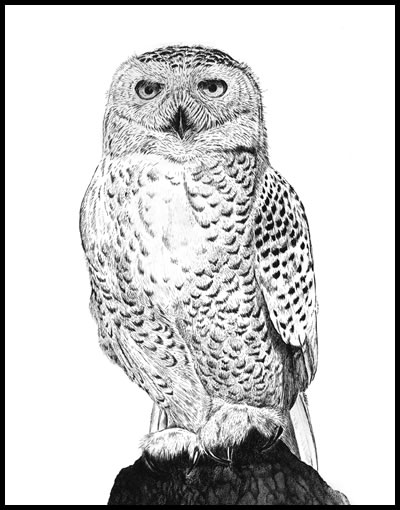| |
| |
| |
| |
| |
| |
| |
| |
| |
| |
| SNOWY
OWL |

|
This striking bird with the great golden eyes is the heaviest of the North American owls, weighing between three pounds for a small male and six pounds for a large female. The snowy also has the greatest wingspan of our nineteen owl species, averaging over five feet across. It is unusual among owls in that the sexes are differently marked. The ethereal-looking male is almost pure white, with some dusky barring on the back, tail and wings. The female is much more heavily marked; only her face, throat and upper chest are pure white. This barred patterning provides effective camouflage when the female is sitting on a nest, which is situated directly on the tundra. The first-year birds are heavily marked like the female. The snowy owl is a bird of the arctic and subarctic, breeding north of the tree line in the Old World as well as in the New World. This owl's numbers and its migration patterns are to a great degree tied to the fortunes of its primary prey species, lemmings and arctic hares (although it will take birds such as ptarmigans, ducks and geese as well). Both mammals undergo periodic population buildups. During peak years, when the tundra swarms with food, a pair of snowies can raise ten or more chicks. Just as the owl population is at its height, the population of the prey, which has been eating all the available vegetation, crashes. When there are too many owls and not enough food, some snowies have to migrate. The first ones to leave are usually the young birds that have not yet established a hunting territory and so are the first to be affected by a food shortage. These irregular migrations are called irruptions, and in the snowy owl they occur roughly every four years. When snowies venture southward, they seek out flat areas that resemble their tundra home. Migrating snowy owls have been observed in fields and salt marshes, on beaches and barrier islands, and at airports. Logan International Airport in Boston, Massachusetts, is a favorite stopover for snowies; in fact, this great flat area at the ocean's edge records more snowies every winter than any other place in New England. The arctic visitors may arrive as early as November and stay as late as April. The highest number of snowies recorded at Logan was during the winter of 1986 - 87, when a total of 49 were banded and tallied by a researcher. On one January day during that winter, 23 snowy owls were counted at the airport! In irruption years snowy owls have been recorded as far south as North Carolina in the East, and Utah in the West. This huge and powerful owl will hunt in daylight, and seems to use its excellent vision as well as its sharp hearing to locate prey. The usual hunting method is to perch on a hillock or rock, and from there scan the surrounding area for the movement or sound of prey. Accustomed to the treeless tundra, snowies in New England usually avoid perching in trees, preferring something lower like a fence post or a dune of beach sand. |